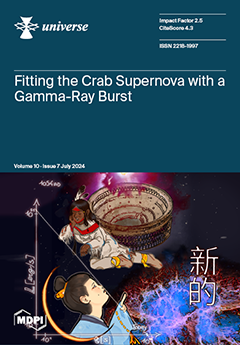A renormalized group improved Schwarzschild black hole spacetime contains two quantum correction parameters. One parameter
represents the identification of cutoff of the distance scale, and another parameter
stems from nonperturbative renormalization group theory. The two parameters are constrained by the data
[...] Read more.
A renormalized group improved Schwarzschild black hole spacetime contains two quantum correction parameters. One parameter
represents the identification of cutoff of the distance scale, and another parameter
stems from nonperturbative renormalization group theory. The two parameters are constrained by the data from the shadow of M87* central black hole. The dynamics of electrically charged test particles around the black hole are integrable. However, when the black hole is immersed in an external asymptotically uniform magnetic field, the dynamics are not integrable and may allow for the occurrence of chaos. Employing an explicit symplectic integrator, we survey the contributions of the two parameters to the chaotic dynamical behavior. It is found that a small change of the parameter
constrained by the shadow of M87* black hole has an almost negligible effect on the dynamical transition of particles from order to chaos. However, a small decrease in the parameter
leads to an enhancement in the strength of chaos from the global phase space structure. A theoretical interpretation is given to the different contributions. The term with the parameter
dominates the term with the parameter
, even if the two parameters have same values. In particular, the parameter
acts as a repulsive force, and its decrease means a weakening of the repulsive force or equivalently enhancing the attractive force from the black hole. On the other hand, there is a positive Lyapunov exponent that is universally given by the surface gravity of the black hole when
is small and the external magnetic field vanishes. In this case, the horizon would influence chaotic behavior in the motion of charged particles around the black hole surrounded by the external magnetic field. This point can explain why a smaller value of the renormalization group parameter would much easily induce chaos than a larger value.
Full article





